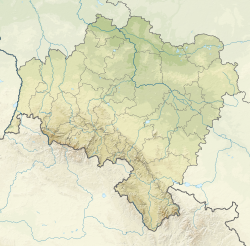
Back لغنيتسا Arabic لجنيتسا ARZ Legnica AST لقنیتسا AZB Лягніца Byelorussian Лягніца BE-X-OLD Легница Bulgarian Legnica Catalan Legnica (kapital sa munisipyo) CEB Lehnice Czech
Legnica | |
|---|---|
| |
|
| |
| Coordinates: 51°12′30″N 16°9′37″E / 51.20833°N 16.16028°E | |
| Country | |
| Voivodeship | |
| County | city county |
| First mentioned | 1004 |
| City rights | 1264 |
| Government | |
| • City mayor | Maciej Kupaj (KO) |
| Area | |
| • Total | 56.29 km2 (21.73 sq mi) |
| Elevation | 113 m (371 ft) |
| Population (31 December 2021) | |
| • Total | 97,300 |
| • Density | 1,765/km2 (4,570/sq mi) |
| Time zone | UTC+1 (CET) |
| • Summer (DST) | UTC+2 (CEST) |
| Postal code | 59-200 to 59-220 |
| Area code | +48 76 |
| Car plates | DL |
| Highways | |
| National road | |
| Website | www.legnica.um.gov.pl |
Legnica (Polish: [lɛɡˈɲit͡sa] ; German: Liegnitz, pronounced [ˈliːɡnɪts] ; Silesian: Ligńica; Czech: Lehnice; Latin: Lignitium) is a city in southwestern Poland, in the central part of Lower Silesia, on the Kaczawa River and the Czarna Woda. As well as being the seat of the county, since 1992 the city has been the seat of the Diocese of Legnica. As of 2023,[update] Legnica had a population of 97,300 inhabitants.[1]
The city was first referenced in chronicles dating from the year 1004,[2] although previous settlements could be traced back to the 7th century. The name "Legnica" was mentioned in 1149 under High Duke of Poland Bolesław IV the Curly. Legnica was most likely the seat of Bolesław and it became the residence of the dukes of Legnica from 1248 until 1675.[3][4] Legnica is a city over which the Piast dynasty reigned the longest, for about 700 years, from the time of ruler Mieszko I of Poland after the creation of the Polish state in the 10th century, until 1675 and the death of the last Piast duke George William. Legnica is one of the historical burial sites of Polish monarchs and consorts.
Legnica became renowned for the fierce battle that took place at Legnickie Pole near the city on 9 April 1241 during the first Mongol invasion of Poland, which ended in the defeat of the Polish-led Christian coalition by the Mongols.
Legnica is an economic, cultural and academic centre in Lower Silesia, together with Wrocław. The city is renowned for its varied architecture, spanning from early medieval to modern period, and its preserved Old Town with the Piast Castle, one of the largest in Poland.[5] According to the Foreign direct investment ranking (FDI) from 2016, Legnica is one of the most progressive high-income cities in the Silesian region.[6][7]
- ^ a b "Local Data Bank". Statistics Poland. Retrieved 9 August 2022. Data for territorial unit 0262000.
- ^ Chisholm, Hugh, ed. (1911). . Encyclopædia Britannica. Vol. 16 (11th ed.). Cambridge University Press. p. 594.
- ^ Smahel, Frantisek (2022). Festivities, Ceremonies, and Rituals in the Lands of the Bohemian Crown in the Late Middle Ages. Martin Nodl, Václav Žůrek. Boston: BRILL. pp. 179, 199. ISBN 978-90-04-51401-0. OCLC 1336402730.
- ^ Thum, Gregor (2011). Uprooted : how Breslau became Wrocław during the century of expulsions. Princeton. p. 225. ISBN 978-1-4008-3996-4. OCLC 744588454.
{{cite book}}: CS1 maint: location missing publisher (link) - ^ "*** LEGNICA *** ZAMEK W LEGNICY *** LEGNICA ***". Retrieved 26 March 2017.
- ^ https://www.um.olawa.pl/attachments/article/601/Polish%20Cities%20of%20the%20Future%202015_16.pdf [bare URL PDF]
- ^ "Dolny Śląsk najbogatszy w Polsce, a Wrocław zaraz za Warszawą (RANKING NAJBOGATSZYCH) - Gazetawroclawska.pl". Retrieved 26 March 2017.
© MMXXIII Rich X Search. We shall prevail. All rights reserved. Rich X Search









